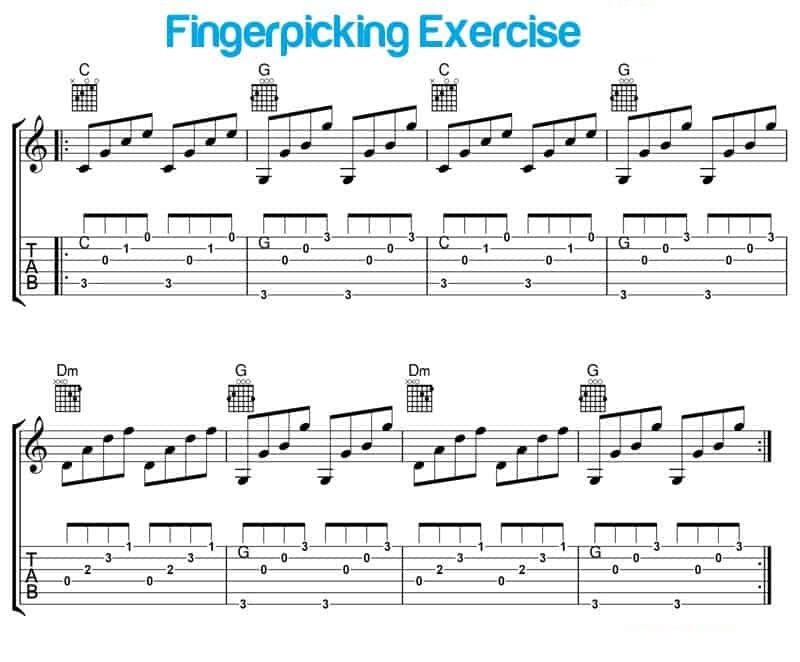Learning guitar fingerpicking can be a rewarding experience that opens up a wide range of playing styles and techniques. Here are some steps and tips to get you started on your fingerpicking journey:
- Know the Basics: Before diving into fingerpicking, ensure you have a solid understanding of basic guitar techniques like fretting, chord shapes, and strumming. This will provide a strong foundation for fingerpicking.
- Choose the Right Guitar: Although you can fingerpick on any type of guitar, some guitars are more suitable for fingerstyle playing. Acoustic guitars with nylon strings (classical guitars) or steel strings (folk guitars) are commonly used for fingerpicking due to their warm tone and responsiveness.
- Start with Simple Patterns: Begin with simple fingerpicking patterns to build your coordination and dexterity. One of the most common fingerpicking patterns for beginners is the Travis picking pattern, which involves alternating the thumb between two bass notes while the fingers pluck the higher strings.
- Practice Regularly: Like any skill, consistency is key to improvement. Dedicate time each day to practice fingerpicking. Even 10-15 minutes of focused practice can yield better results than sporadic, longer sessions.
- Use Metronome: Using a metronome is crucial for developing good timing and rhythm. Start with a slow tempo and gradually increase the speed as you become more comfortable with the patterns.
- Learn Songs You Love: Choose songs that you enjoy and that are suitable for fingerpicking. Learning songs you love will keep you motivated and engaged with the practice.
- Learn Fingerpicking Patterns: Explore different fingerpicking patterns beyond the basic Travis picking. Some patterns include arpeggios, plucking individual strings, or combining thumb and finger movements in different ways.
- Study Fingerstyle Players: Watch and learn from accomplished fingerstyle guitarists. Observe their hand positions, techniques, and how they execute various patterns. This can be done through instructional videos, online tutorials, or attending live performances if possible.
- Master Finger Independence: Develop finger independence by practicing exercises that focus on strengthening each finger’s ability to play independently. This will improve your accuracy and overall dexterity.
- Be Patient and Persistent: Fingerpicking takes time to master, so be patient with yourself. It’s normal to encounter challenges along the way, but don’t get discouraged. Stay persistent, and you will see progress with consistent effort.
- Experiment and Create: Once you feel comfortable with fingerpicking, don’t be afraid to experiment and create your own fingerstyle arrangements of songs or original compositions. This will enhance your creativity and personal style.
Remember that fingerpicking is an ongoing learning process, and even experienced guitarists continue to refine their skills. Enjoy the journey and have fun exploring the beautiful world of fingerstyle guitar playing!
Guitar Fingerpicking Guide Pdf

Can I Learn Guitar in 1 Month ?
It is possible to learn some basic guitar skills in 1 month, but it is unlikely that you will become a proficient guitar player in that time. Learning guitar takes time, practice, and dedication. If you are willing to put in the work, you can make significant progress in 1 month.
Here are some tips to help you learn guitar in 1 month:
Set realistic goals. Don’t expect to be able to play like Jimi Hendrix in 1 month. Set some realistic goals for yourself, such as learning a few basic chords or being able to play a simple song.
Practice regularly. The more you practice, the better you will become. Try to practice for at least 30 minutes a day, 5 days a week.
Find a good teacher or online course. A good teacher can help you learn the basics of guitar playing and give you feedback on your progress.
Be patient and persistent. Learning guitar takes time and effort. Don’t get discouraged if you don’t see results immediately. Just keep practicing and you will eventually reach your goals
How much time would it take to learn guitar?
It depends on how much time you put in, but with regular practice, you can learn the basics in a few months and be playing your favorite songs in a year.
Hi there colleagues, how is everything, and what you wish for to say on the topic of this piece of writing, in my view its truly awesome in favor of me.